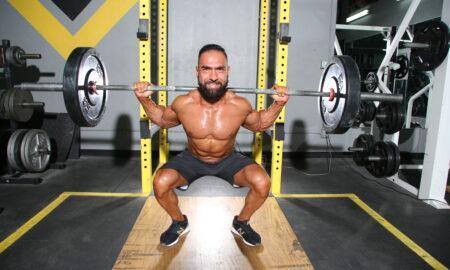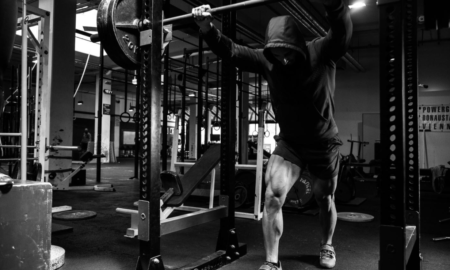I have a confession to make: I’ve been training like a bodybuilder.
After years of heavy power training—years upon years of heavy triples, doubles and singles performed with supermaximal poundages, my body just couldn’t take it anymore. For six months I couldn’t even lift a weight due to several herniated cervical disks. Finally I had to have surgery.
The doc’s advice: “Don’t ever train heavy again!” What, was the guy crazy? I love lifting heavy weights. It’s the most addictive thing I’ve ever experienced. I’ve never tried heroin, but I’m pretty damn sure that I wouldn’t find it as addictive as getting under a 500-pound squat and cranking out a few triples.
Nevertheless, when I recovered from my surgery and it was time to start pumping the iron again, I knew it was also time to make some changes to my training. So I decided to trade one addiction for another. I traded in the addiction of the max single for the addiction of the monster pump. “Pump” training was my original love, after all. I even wrote about it in IRON MAN in the mid-’90s.
One thing was certain, however: I wasn’t about to start training like the average pro bodybuilder. I decided that my new-style bodybuilding training was going to be state of the art. I was going to take all of the stuff I learned from years of powerlifting and power building and apply it to some serious hypertrophy training. This bodybuilder was going to be 21st century—cutting-edge as hell.
The Principles of Mass Construction
There are several cutting-edge training principles that will empower you to pack on the most muscle growth in the shortest time possible. I’ll start by discussing the most important principle; the others fall into place.
Principle 1: Volume Is King!
”Whoa!” some of you are saying. “Hold your friggin’ horses, Sloan, ’cause there’s no way that principle can be right. We’ve read Mike Mentzer, and while we might not agree with everything he had to say, we do know that less is better.”
Not so fast. Not only is less not better, but more is a helluva lot better. The key is knowing how to apply the volume, when to pour it on and when to back off—we’ll get to backing off in a bit. First, I want to spin a little tale about myself—how I first discovered there might be a lot more to this volume business than I ever realized.
A few years ago I was training for a powerlifting meet in the Deep South. A couple of training partners I lifted with wanted to try one of those crazy Russian-style squat routines. I decided, What the hell—might as well give it a shot. If we were going to follow a Russian-style squat routine, though, we were going to do the entire program. We were going to train our bench presses and deadlifts Russian-style too.
The program we followed had us bench-pressing three times per week, squatting twice each week and deadlifting twice each week. The squatting and deadlifting were done on different days, which meant that we were training our hamstrings, glutes, and lower back a total of four times each week. None of the workouts we did were light on volume.
I definitely had my reservations at first. After a few weeks, however, I was sold. My squat had never been stronger, and my deadlift and bench press were increasing. The only problem: I was gaining too much muscle, funny as that may sound. The routine wasn’t meant for someone trying to stay in a weight class, but it was fantastic for a trainee trying to pack on pounds. I had to actually decrease the amount of work I was doing in each workout in an attempt to stay in my weight class.
Still, I’d learned a lesson, one that I’m now applying to my new hypertrophy workouts. Volume definitely rocks! You just need to know how to manipulate it to get the best results. That’s where the following principles come in.
Principle 2: Volume Might Be King but Squatting Is Queen
Volume training combined with lots of squatting is the most surefire way imaginable to pack on muscle mass. You want to increase your bench press? Squat more. Want to gain 30 pounds of muscle? Squat more. Want big arms more than anything else in the world? Squat more.
Get the picture? Those answers have one thing in common. You’ve got to squat if you’re serious about gaining muscle mass.
Principle 3: Full-Body Workouts Are the Best
If volume is king and squatting is queen, then full-body workouts are the aces up your muscle-building sleeve. Combining plenty of volume with squatting and full-body workouts is like creating a muscle-building cocktail—a cocktail that, once ignited, is hard to put out.
Principle 4: Stay Away From Failure
When training with high volume—lots of sets, full-body workouts three days each week—you want to stay the heck away from muscle failure for the most part. You’ve probably heard people say that you can train either hard or long but not both. True enough, but most people just don’t understand that training long is better than training to failure.
Even though I’m outlining a state-of-the-art program, it’s not really anything new. Bodybuilders of old knew very well that it was better to train long than it was to train hard. Most classic bodybuilders from the ’60s and earlier trained their muscle groups three times each week. They didn’t do it because they’d read some newfangled study that told them it was the best way to go. They trained that way because they’d tried every bodybuilding workout under the sun and that was what worked best for them. Besides, they knew that in order to train their muscle groups so frequently, they’d have to avoid muscle failure.
Principle 5: Keep Your Reps Moderate
When training with a lot of volume, you want to avoid a couple of things besides training to failure. One, you don’t want to train with incredibly heavy weights. Why? Because that would have you approaching or hitting failure on all of your sets, and, as we saw in our fourth principle, failure is bad. In other words, you can’t do 10 sets of max triples and not expect to burn out.
That doesn’t mean you can’t do 10 sets of three; it just means that the weight should be only moderately heavy if you keep the reps that low. Also keep in mind that when you’re trying to build maximum muscle mass—not maximum strength—your reps can be a little higher.
The second thing you need to avoid when training with a lot of volume is doing too many reps on each set. High-rep sets combined with a high number of sets can add up to too much workload in a single session. That’s what leads to overtraining, not volume workouts in and of themselves.
What’s an ideal rep range for a bodybuilder solely interested in building muscle? I’d say anywhere between six and 12 reps, with six to eight being best.
Principle 6: Know When to Back Off
Funny thing about those Russian workouts my lifting partners and I were doing: Every four weeks the volume would drop for one week. I’ve noticed something else about all other great workout programs that rely on volume, whether they’re a Soviet-inspired squat regimen or a bench workout from the famed Westside Barbell Club of Columbus, Ohio. Almost all of them call for a break after three weeks of hard training. That doesn’t mean you have to lay off for an entire week; it just means cutting back on sets and reps.
In fact, principle 6 is the key to making big gains with volume workouts. In case you haven’t figured it out, not backing off every few weeks is the reason that most people get absolutely nowhere when training with high volume.
Creating the Ultimate Workout
Okay, knowing the principles as we now do, let’s see what a really great training program would look like and how you can keep the gains coming after completing it. What follows is a four-week cycle. Study the entire program several times before hitting the gym.
Closing Words
I always enjoy hearing from lifters, so if you want to e-mail me with thoughts or questions you can do so at [email protected]. You can also visit my Web site at web.mac.com/cssloan.
Forget about the things you thought you knew about training and give this program an honest try. You’ll be pleasantly surprised with the results. IM




















You must be logged in to post a comment Login